Probing the origins of vibrational mode specificity in intramolecular dynamics through picosecond time-resolved photoelectron imaging studies
Abstract
We have studied the intramolecular dynamics induced by selective photoexcitation of two near-isoenergetic vibrational states in S1p-fluorotoluene using picosecond time-resolved photoelectron imaging. We find that similar dynamics ensue following the preparation of the 13111 and 7a111 states that lie at 1990 cm−1 and 2026 cm−1, and that these dynamics are mediated by a single strongly coupled doorway state in each case. However, the lifetimes differ by a factor of three, suggesting an influence of the vibrational character of the modes involved. Our results clearly show the contribution of torsion-vibration coupling to the dynamics; this is further corroborated by comparison with the 7a111 state in S1p-difluorobenzene, which lies at 2068 cm−1. We invoke a model in which van der Waals interactions between methyl hydrogen atoms and nearby ring carbon and hydrogen atoms leads to mixing of the vibrational and torsional states. This model predicts that enhanced torsion-vibration coupling occurs when mode 7a is excited, consistent with our observations.

- This article is part of the themed collection: 2017 PCCP HOT Articles


 Please wait while we load your content...
Please wait while we load your content...